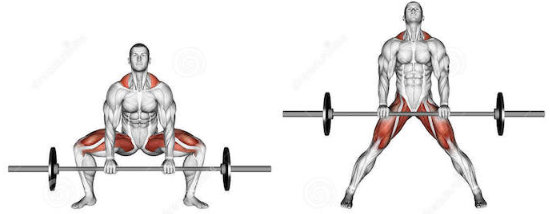Hamstring exercises play a crucial role in developing and strengthening your legs. The so-called femoral muscles, located at the back of the thigh, are essential for knee stability and general mobility. Although the femoral muscles are not so easily observed with the naked eye, they are still essential for physical activity.
Therefore, integrating specific exercises, such as leg extensions and hamstring curls, into your routine not only contributes to sculpting more toned legs, but also optimizes functional performance and prevents injuries. Below, we show you 15 hamstring exercises that will bring you great benefits.
Romanian deadlift
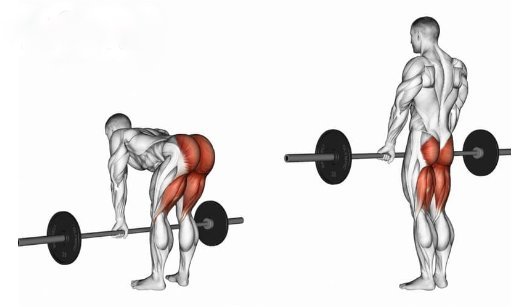
This exercise stands as a fundamental pillar in strengthening the femoral muscles. When performing this exercise, the contraction of the hamstring muscles is emphasized, which not only improves strength, but also the flexibility of the back of the legs. Both are essential for development in all types of activities, including those of lower intensity.
Likewise, precise execution (by staying with your back straight and core contracted) maximizes muscle activation, which contributes to balanced and resilient development. Perhaps it is not the most frequented or well-known femoral exercise , but it is clear that it is very beneficial.
- Use a weight that allows you to do at least 15 repetitions. Stand in front of the bar and place your feet shoulder-width apart. Grip the bar shoulder-width apart, keeping your arms slightly outside your legs.
- You will start standing, standing straight and holding the bar with your arms straight.
- Take a breath. To properly isolate the femoral muscle in this exercise, you have to lower the bar close to your legs. Move your glutes and hips backward to notice the effort in the hamstrings and glutes. Your legs may be slightly bent, but not too much. Bending your legs too much will make the exercise become a normal deadlift and would lose its effectiveness in working the hamstrings and glutes.
- Each person has different flexibility. For this reason, everyone will not be able to lower the bar to the same height. The bar should be below the knee or even near the instep of the foot. Do not curve your back excessively while lowering the bar.
- Then, stand back up and exhale to complete one repetition.
Lying leg curl on machine or hamstring curl
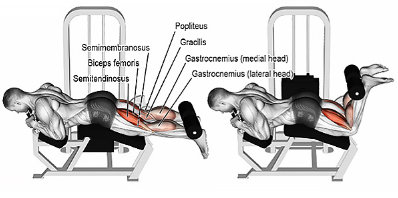
The lying hamstring curl on the machine stands out as a highly effective isolation exercise for the hamstring muscles. The reason is that, when using the machine, the effort is concentrated on the posterior thigh muscles, which promotes definition and strength and, therefore, development capacity.
It should be noted that the supine position ensures a controlled range of motion. Consequently, stress on the lower back is minimized and attention is focused on the target muscle group. Correct strengthening and a greater capacity to respond to high demands are the keys to this femoral exercise . Learn to do it.
- First, you should adjust the machine to a height where you are comfortable. The roller should be above the ankle. Your knees will be at the end of the bench.
- Now, you have to lie face down on the bench. You can grab the handles that the machine will have with your hands. The best load for this exercise is a weight that allows you to complete about 15 repetitions.
- Fill your lungs with air and use an explosive movement to bend your legs and bring the roller closer to your buttocks. Focus on contracting the gluteus and hamstrings well at the end of the movement. Afterwards, you can release your breath.
- Return the weight to the starting position in a controlled manner. Never let the weight plates hit each other. Maintain tension throughout the movement.
This exercise is also called lying machine leg curl .
Bench hyperextensions
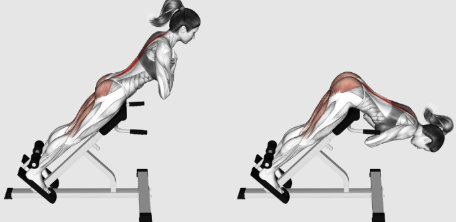
Although hyperextensions are not considered essential, they can serve to improve the femoral and gluteal muscles. This exercise, performed in a prone position on an incline bench, intensely activates the posterior chain. Controlled backward extension works the hamstring muscles, resulting in greater lumbar stability and improved posture.
In this type of exercise, it is evident how the level of muscle training and posture go hand in hand. Both are complementary and necessary for correct performance.
Attention! There is a special way to do this exercise if you want to notice the effort in the hamstring. Do it as we indicate!
- Position yourself on the hyperextension bench as if you were going to do conventional lumbar extensions. However, there will be a difference in this case: you have to lower your head and put your chin close to your body. Try curling up on yourself as if you were a "human ball."
- Now, take a breath and start lowering your body as much as your mobility allows.
- Then, raise your trunk until you can align your back with your legs. At this point, release all the air.
This is the proper way to isolate the hamstring in this exercise (and not the lower back). To add difficulty, try holding a dumbbell or plate between your arms.
Glute kick
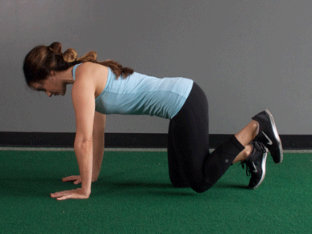
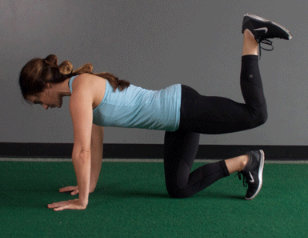
This movement stands as a dynamic option that not only tones the glutes, but also optimizes the femoral muscles and the entire posterior area of the leg. The exercise is performed in a quadruped position. This movement focuses effort on the back of the legs to improve muscle definition and biomechanical function.
Therefore, the glute kick is ideal for sculpting and adding versatility to the training routine, which almost by default results in aesthetic and functional benefits. These hamstring exercises are very necessary for everyday physical activity, whether running or practicing a high-effort sport.
- You can use a mat to do this bodyweight hamstring exercise.
- Get into a quadruped position on the mat. You will keep your knees below your hips and your hands below your shoulders.
- Retract your shoulder blades. Additionally, you must contract the pelvic floor and core.
- It is about extending your hips and bringing your right heel towards the ceiling, but you must make sure to always keep your knee at 90º.
- Return the leg to the starting position in a controlled manner.
- Repeat the movement several times to get as many repetitions as you want.
- Then do it with the other leg.
- Do not move your back during the movement. Also, focus on keeping your spine compact by tightening your core muscles.
Glute kick on the multihip machine
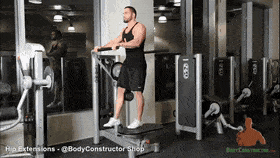
This is another glute kick exercise, but it is done on a gym machine. This exercise can be done in several ways:
- With a specific machine for glute kicks.
- With the multi-hip machine.
- Using a low pulley (with an ankle strap).
- Using elastic bands (train at home).
Let's see how the glute kick would be done on a multi-hip machine at the gym:
- First, choose a suitable weight and place the roller of the machine behind your knee joint.
- Start with your legs together. The leg that is holding the roller (you are going to exercise it) will be slightly forward of the other leg.
- Fill your lungs with air and do an explosive kick backwards. Then release all the air.
- Bring the roller to the starting position in a controlled manner.
- Alternate both legs. Do your reps with one leg first and then the other.
This is an isolation exercise for the glutes and hamstrings .
Seated leg curl on machine
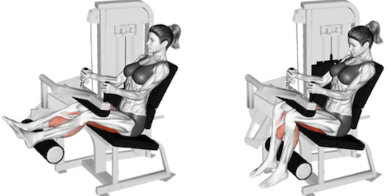
He seated machine hamstring curl can be classified as a highly effective exercise for isolating and strengthening the hamstrings. Since you adopt the seated position, you minimize the participation of other muscle groups, allowing you to concentrate the load on the back of the legs.
This precise approach encourages balanced muscle development and also reduces stress on the lower back. In turn, the machine provides optimal control of movement and allows personalized adjustments according to the desired level of resistance. This is a valuable option for sculpting and toning the hamstrings.
- To do the seated hamstring curl exercise, you will have to sit on the machine with your ankles on the roller. Normally, this machine also has another roller to place the knees or legs.
- Take a deep breath and push the roller down with your legs.
- Then, slowly raise your legs until your knees are almost (but not completely) straight back to the starting position. You should feel the tension of the exercise in the back of your legs (hamstrings).
- Do this exercise in a controlled way to see maximum results. About 12-15 repetitions per set will be adequate.
This move is also known as machine seated leg curls .
Kettlebell swing
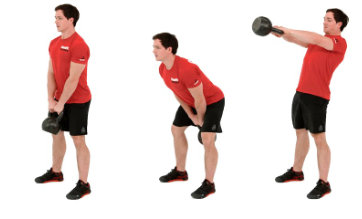
If we had to define it in a few words, we could say that it is a dynamic and energetic exercise. However, it is much more than that, as it works as an effective tool to activate the hamstrings. . It is a rocking movement, initiated from the hips, that intensely recruits the hamstring muscles with each forward swing.
It should be noted that the involvement of the hamstrings in this full-body exercise leads to increases in both strength and power, while contributing to core stability. The kettlebell swing offers versatility and efficiency, and is a valuable addition to any training routine.
- Stand up and keep your feet shoulder-width apart. Hold a kettlebell with both hands. Leave your palms facing you. You will start with your arms extended downward.
- Take a deep breath, move your hips back and bend your knees slightly to put the kettlebell between your legs. You have to keep your back straight and activate your trunk.
- Now, release your breath. You have to squeeze your glutes and push your hips forward. Raise your body to a standing position. Have your arms swing the weight as far as you can reach naturally. Your goal will be to reach shoulder height with the weight or keep it parallel to the ground. You do not need to use arm strength to lift the kettlebell during the movement. It may take several movements to find your rhythm and maximize lift.
- Take a breath and lower the kettlebell between your legs, bringing your hips back and slightly bending your knees.
- Perform 2 to 3 sets of 10 to 20 repetitions or continue doing the movement for as long as you want (for example, repetitions in a row in 5 minutes).
There is another version of this exercise called American style, where the kettlebell is carried above the head, finishing the movement with the arms straight and in a vertical position.
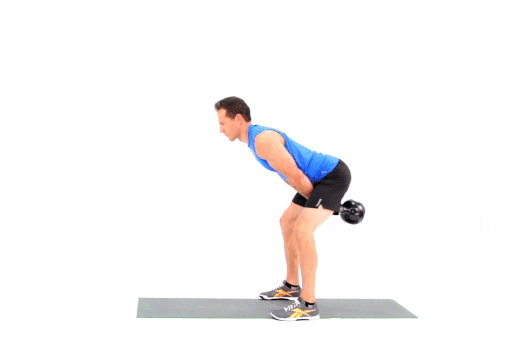
Are you interested?:
Romanian One-Leg Dumbbell Deadlift
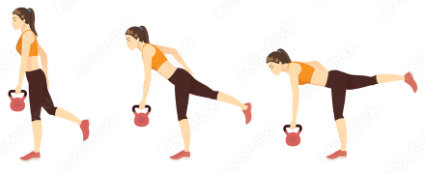
This version increases the complexity of the classic exercise by focusing the work on the hamstrings and improving stability. By applying the deadlift unilaterally, the load is accentuated on one side only, which challenges balance and simultaneously strengthens the posterior musculature.
The use of the dumbbell intensifies the stimulus on the femoral muscles, which leads to symmetrical and functional development. This exercise not only contributes to muscle strength and definition, but also improves coordination and stability. For this reason, it is a valuable alternative.
- Standing with your feet together, hold a dumbbell in each hand in front of your legs. This will be the starting position.
- Shift your weight toward your left leg and slightly bend your left knee. Lift your right leg behind your body, bend your hips so your torso is parallel to the floor, and lower the weight toward the floor.
- Keep your back straight. At the bottom of the movement, your body and right leg should be almost parallel to the floor, with the weight a few inches off the floor. If your hamstrings are tight, you may not be able to lift your leg as high.
- Keeping your abs tight, push through your left heel to straighten up and bring the weight back to the starting position. Place your right leg against your left leg, but try to keep most of your weight on your left foot.
- Pause in this position and squeeze your glutes. Do several repetitions with one side and then switch to the other.
Doing single-leg deadlifts works the hamstrings and glutes. Plus, it requires quite a bit of balance. Maybe you can use one dumbbell instead of two and lean lightly on a wall or sturdy object to stay in the position.
Good morning with bar
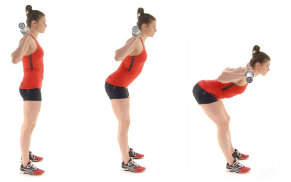
With a striking and curious name, this movement is positioned as a classic and powerful exercise to strengthen the hamstrings and lower back. When performing it, the bar is placed on the back of the shoulders. By flexing the hip forward, the hamstring muscles are intensely activated.
However, good morning with a bar is much more than an aesthetic exercise. It serves to increase strength and achieve greater flexibility in the posterior chain. Additionally, movement helps develop strong posture. Precise execution, keeping the back straight, guarantees the effectiveness and safety of the exercise making it a valuable option for leg training and lower back health.
- Stand with your feet hip-width apart and your hands next to your ears. This is the version without extra weight, although it is most convenient to put a barbell with weights on your back (which you will hold as in the starting position of the barbell squat).
- Maintain a gentle bend in your knees. Now, fill your lungs with air and bend your hips forward and push your buttocks back while leaning your body forward. Stop when your body is just above parallel to the ground.
- Drive your hips forward as you lift your body and return to the starting position. Squeeze your glutes when you reach the top and exhale. This is a repetition.
The exercise really works the muscles of the posterior chain, including the glutes, lower back, and hamstrings (femorals).
Reverse lunge
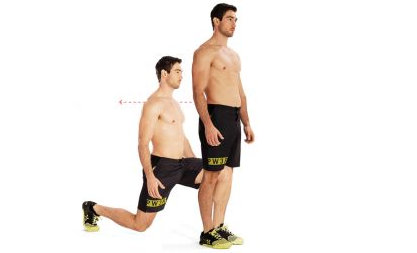
This is presented as a versatile exercise that not only works the hamstrings effectively, but also involves other muscle groups to provide comprehensive benefits. When you step back with one leg and lower yourself toward the ground, you activate your hamstrings and glutes. Consequently, the back of the legs is optimized and greater stability is provided to the hips.
Additionally, the reverse lunge requires significant balance, which helps develop coordination and strength in the stabilizer muscles. This exercise, which can be performed with or without additional weight , is easily adapted to different fitness levels. For these reasons, it is very effective in sculpting the legs and improving body functionality.
- The reverse lunge is always a static movement (that is, it is not necessary to move from the spot).
- To do the exercise, you have to step back with one leg. Touch the floor with your toe and lower your knee until it almost touches the floor.
- After lowering, the other leg will be bent at the knee and forming a 90º angle. After completing one rep, stand back upright.
- Do one repetition with each leg alternately.
The ideal is to hold a dumbbell in each hand to do this exercise.
Lying leg curl on bench with dumbbell between legs
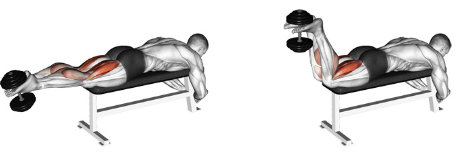
This exercise is designed to work on the femoral muscles with the aim of strengthening them and providing them with various benefits, such as a greater capacity for development and less probability of suffering injuries and even pain due to overexertion. Being in a supine position on a bench maximizes your range of motion, while the dumbbell adds resistance to intensify muscle activation.
This precise approach contributes to the development of toned hamstrings and also minimizes stress on the lower back. The hamstring exercise is an effective and safe option.
- Begin the dumbbell femoral curl while lying on a flat bench. Ideally, this bench should be somewhat elevated from the ground so that you can achieve a greater range of motion.
- Choose a dumbbell with a suitable weight and place it on the floor near the end of the bench.
- Lie face down on the bench so that your knees are on the edge of the bench.
- Lift the dumbbell off the floor with your feet. Place the weight between the arches of both feet.
- Your legs should be fully extended. You can wrap your arms around the bench for greater stability. This will be the starting position.
- Now, simply take a breath and bend your knees, do a hamstring curl movement and slowly bring the dumbbell towards your buttocks. Then, let out the air.
- Move the dumbbell as far as you can or, at least, go past 90 degrees.
- When the dumbbell touches your buttocks, you can pause briefly and then return the weight to the starting position in a controlled manner.
- Do as many repetitions as you want.
Are you interested?:
Bulgarian squat
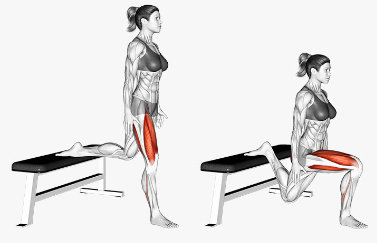
The Bulgarian squat is distinguished as a unilateral exercise that challenges the strength and stability of the hamstrings. When performing this movement, with one foot elevated behind, the load is concentrated on the front leg, intensely activating the hamstring muscles. .
This is a squat variant that promotes balanced leg development, improves coordination and motor control. It should not be considered the only option, but rather a complement to other exercises. How to do Bulgarian squats?
Place a bench, chair, box or other flat, sturdy object against the wall. The platform should be at knee height.
Stand two to three feet in front of the platform with your back to it.
Extend your right leg behind you and place the top of your foot on the platform. Your hips and shoulders will be in a straight line (aligned).
Tighten your abdomen and lower yourself until your right thigh is parallel to the floor. Don't lean too far forward.
You want to keep your weight over the entire length of your leg (don't stand on your toes or roll on the outside of your feet).
Push using force with your heel to return to the starting position.
Breathe in before going down and release it when going up.
When you have finished doing several repetitions with one leg, do a set of repetitions with the other leg. Alternate both legs.
Hamstring leg press
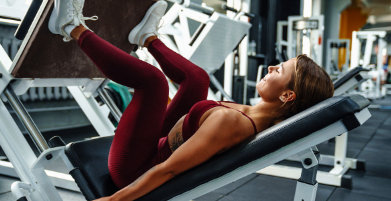
Here we have a key exercise for the comprehensive development of the legs. This is a variant where, by adjusting the position of the feet on the platform, the load is focused on the hamstrings to strengthen this muscle group effectively. Controlling movement and maintaining proper posture guarantee optimal activation of the femoral muscles, which contributes to the development of strength and muscle mass in this area.
On the other hand, to get great benefits from the hamstring leg press exercise, your legs should be placed as high on the platform as possible and as far apart as possible.
- Sit on the machine and place your feet on the top of the platform. Spread your feet as far apart as you can; take them to the corners of the platform.
- Take a breath and lower your legs until your knees almost touch your chest.
- Push the platform with an energetic, explosive movement. Do not lock your knees at the end of the movement to maintain tension. Release the air.
Sumo squat
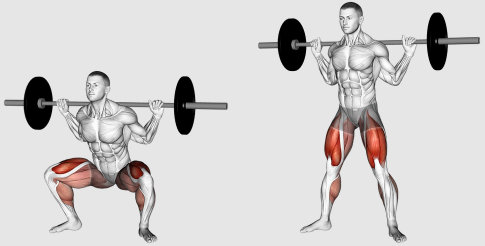
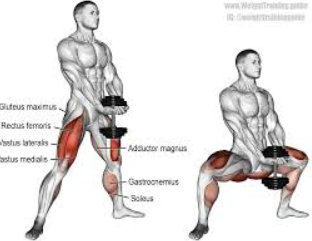
The sumo squat is characterized by a wide positioning of the feet, which places emphasis on the hamstrings and glutes . Specifically, when lowering the body towards the ground, the hamstring muscles are intensely activated. This squat promotes strength and flexibility in the back of the legs. In addition, it effectively works the abductors and adductors, which implies comprehensive benefits for the lower body and contributes to obtaining a toned figure.
There are several ways to do sumo squats: you can place a barbell on your shoulders (as in the conventional squat), grab a dumbbell to lower it between your legs, or even use the person's own body weight.
- If you are going to use a barbell, you need a support to take the bar out and place it on your shoulders. Take a couple of steps back when you have the bar over your trapezius and shoulders. Grip the bar tightly with your hands.
- You need to open your feet more compared to a conventional squat. Your feet should be farther from your shoulders and hips. You yourself must find the ideal opening for you. Turn your toes at an angle of about 45º (pointing slightly outward).
- When you are well positioned, look forward, take a breath and begin to bend your knees and lower your hips.
- On the way down, remember to push your heels hard against the ground and drive your glutes toward your heels.
- Lower your torso as much as you can or your flexibility allows and then go back up in one vigorous movement.
- When you are upright again, release the air from your lungs.
Tip: Squeeze your glutes at the top of the movement to localize the stress on your gluteal and hamstring fibers.
A weight that allows you to do between 12-20 repetitions will be good to start.
The wide leg stance also strengthens the inner thigh muscles (abductors) in this exercise.
You can also use a dumbbell that you will hold with your arms straight, between your legs.
Do this hamstring exercise at home using simply your own body weight.
Weighted glute bridge
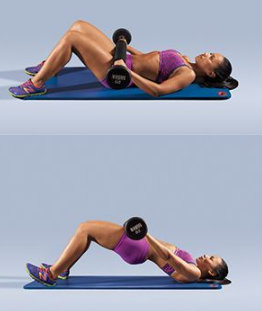
We reveal another effective exercise to strengthen the hamstrings and glutes. When you elevate your hips while holding a weight over your pelvis, muscle activation in the back of your legs is intensified. Therefore, this exercise is essential both to tone the glutes and to strengthen the hamstrings. The two main benefits are: improved lumbar stability and injury prevention.
- Lie on your back with your knees bent and your feet hip-width apart on the floor. Hold a dumbbell in each hand and place them just below your hip bones. You now have the starting position.
- First, fill your lungs with air. Squeeze your glutes and abs and push through your heels to lift your hips a few inches off the ground until your body forms a straight line from your shoulders to your knees.
- Hold the position for a second, exhale, and then slowly lower your hips back to the starting position. This is how you do a repetition.
- For additional activation of the hamstring muscles, place your feet slightly away from your glutes.
It is one of the hamstring exercises that you can do at home simply using your body weight.
Sumo deadlift
The deadlift is shown to be a powerful exercise to work the hamstrings, glutes and the posterior chain as a whole. By adopting a wide stance with your feet , the activation of the hamstring muscles is accentuated when lowering and raising the bar. The sumo deadlift is ideal for developing strength and muscle mass in the hamstrings, while optimizing hip mobility and lumbar stability.
Get the multiple benefits of the sumo deadlift. It is a highly recommended exercise for highly demanding athletes, in whatever activity (gymnastics, athletics, volleyball, soccer, etc.) they perform.
- Use a weight that is difficult for you to lift for 10 to 15 repetitions, for example. Some gym users can move quite a bit of weight in this exercise.
- Stand in front of the bar and keep your feet wide apart. Each person must find their ideal opening. Your elbows should be above your knees as you lower the bar. In the starting position, your feet should be facing slightly outwards.
- Now, grab the bar shoulder-width apart. Certain lifters are more comfortable with a closer grip.
- Start with your shins near the bar. Crouch down and tilt your hips back (pull your buttocks back) and bend your knees.
- To do the movement, take a breath and lift the weight off the ground. You have to use force by pushing your heels hard against the ground. Come to an upright position and finish with your hips and knees locked. Remember that you must fully extend your hips at the end of the rise. Breathe out of your lungs when you are up.
- Afterwards, you must go down. Bend your hips and knees to return your weight to the floor.
As you will see, each hamstring exercise offers more advantages than you thought. All of these movements not only serve to stretch, balance a muscle decompression or provide a feeling of relief. Carrying them out is considered essential for all types of activities.
Remember that each of the hamstring exercises that we show you has to be applied in a precise and correct way. Otherwise, it will not provide you with all the desired positive results and would even increase the risk of suffering certain injuries. Training with good technique is quality.


